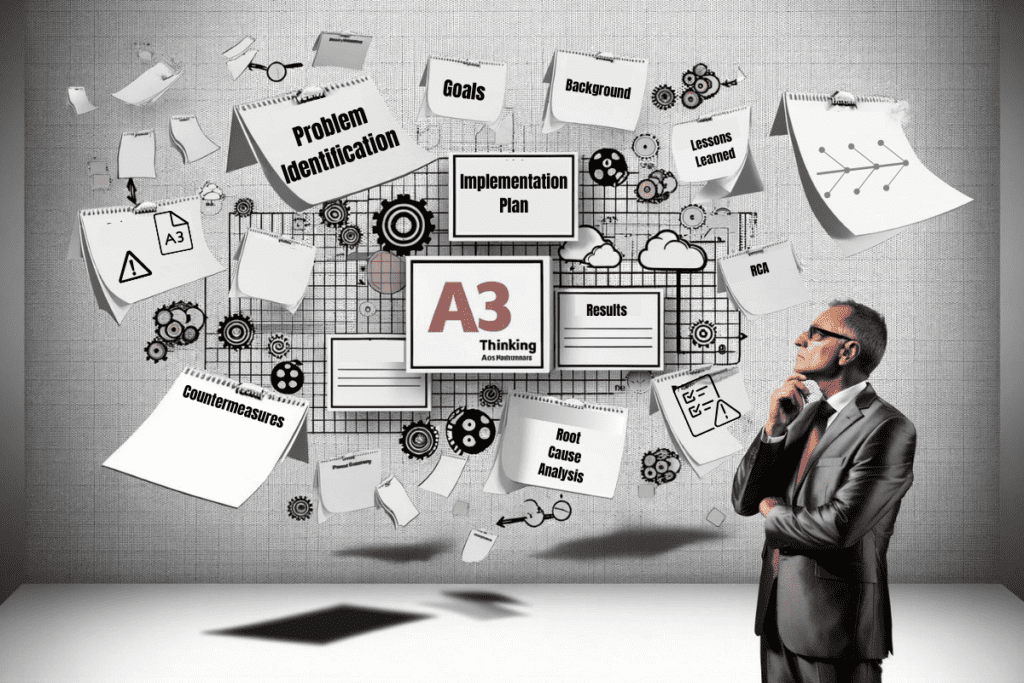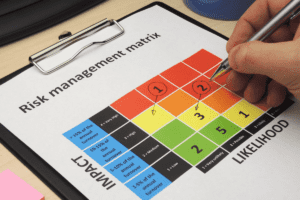5 Types Of A3 Thinking: The Role Of A3 Thinking In Continuous Improvement
Are you struggling to improve your team’s problem-solving skills? You’re not alone. A3 thinking is a proven method that helps teams solve problems logically and efficiently. In this article, we’ll explore the 5 types of A3 thinking and show you how they can boost continuous improvement in any setting. Keep reading to discover the power of A3 thinking!
Key Takeaways
- A3 thinking helps teams solve problems quickly and efficiently with reports that fit on a single piece of paper. This method uses the Plan-Do-Check-Act cycle to find solutions.
- The five types of A3 reports—Problem – Solving, Proposal, Status, Strategy, and Process Improvement—meet different needs from tackling specific issues to planning for the future.
- Using A3 in an organization encourages everyone to take part in solving problems. This makes processes better over time.
- Every type of A3 report has key parts like identifying problems, finding root causes, making action plans, and checking results which help teams work better together.
- Learning how and when to use each type of A3 can make work projects more successful by keeping things clear and simple.
Key Takeaways – 5 bullet points
Here are the key insights you should know about A3 Thinking and its vital role in continuous improvement:
- A3 reports focus on solving problems in a clear, concise way. These one-page documents use the Plan-Do-Check-Act (PDCA) method to find solutions.
- Originating from Toyota’s production system, A3 Thinking targets continuous enhancement across all company aspects by fostering team collaboration.
- This approach not only aims at solving current issues but also promotes a culture of ongoing improvements within an organization.
- Key components of A3 Thinking include identifying the problem, analyzing root causes, developing an action plan, and monitoring progress towards the solution.
- Implementing A3 in your organization encourages everyone to engage in problem – solving and contributes to overall process enhancements.
Why read this article?
This article sheds light on the A3 thinking methodology, a strategy developed by Toyota for solving problems and fostering continuous improvement. By reading this, you gain insight into how to apply the A3 process across different scenarios to enhance problem-solving approaches.
The focus is on five types of A3 templates which are essential tools in building design and other industries seeking streamlined operations.
You will learn about each template’s usage, key components, and steps in deploying them effectively. Through examples provided, the article illustrates practical applications of A3 thinking from simple problem identification to strategic improvement efforts.
This knowledge equips you with techniques for applying lean principles and engaging in systematic approaches like the PDCA cycle for better management and operational efficiency.
What is A3 Thinking?

A3 Thinking is a structured problem-solving and continuous improvement approach from Toyota that fits on a single sheet of A3 paper. Keep reading to discover how it can transform your work!
List of 5 types of A3 Templates
A3 thinking helps teams solve problems and improve processes. It fits on a single sheet of paper, making complex problems easier to understand.
- Problem-Solving A3: This template guides you through identifying and solving a problem. It starts with understanding the current situation, then moves to finding the root cause, creating corrective actions, and implementing a plan. Use it when you need to tackle issues and find effective solutions.
- Proposal A3: Use this layout to propose new ideas or changes. It helps you explain your proposal clearly, showing the current state, the proposed future state, and the steps needed to get there. This format is great for presenting new projects or improvements.
- Status Report A3: This design keeps track of progress on ongoing projects or activities. It outlines objectives, current conditions, next steps, and any issues faced. It’s perfect for regular updates to ensure everyone is aware of how things are moving.
- Strategy A3: This structure is used for strategic planning. It allows you to outline long-term goals, strategies to achieve them, and action plans. The focus is on aligning team efforts towards broader organizational objectives.
- Process Improvement A3: Focuses on enhancing existing processes. You document the current process, identify areas for improvement based on lean principles like value stream mapping, and plan corrective actions to implement improvements.
These templates cover various needs from solving specific problems to strategizing for the future or improving processes continuously.
Next up: Understanding the key components that make these templates work effectively in diverse situations.
Understanding A3 Thinking: Key components and structure
After exploring the different A3 templates, it’s important to understand their core parts and layout. Each A3 report has a clean and organized structure that fits onto a single sheet of A3 paper (11 x 17 inches).
This format helps keep information concise and focused. The key components usually include the problem statement, root cause analysis, proposed countermeasures, an action plan, and follow-up actions.
Visual aids like diagrams or Ishikawa (fishbone) charts often support these sections for clearer understanding.
Writing the report demands lean thinking and a good grasp of the problem at hand. Start by clearly defining the issue you’re working on. Then, use tools like the 5 Whys technique to drill down to its root causes.
Next, brainstorm and list potential solutions or improvements before deciding on a specific course of action. Set clear goals for what you aim to achieve with your chosen solution(s).
Finally, outline steps to implement these solutions along with how you’ll check their effectiveness over time—this ensures continuous improvement in processes or projects.
When to use the A3 Problem Solving Approach
A3 is perfect for tackling complex issues by breaking them down into manageable parts. It guides teams through the problem-solving process, from identifying and understanding the challenge to brainstorming solutions and executing an action plan.
By using A3, organizations foster collaboration, allowing everyone involved to see the big picture and contribute their insights. This method shines in situations where a clear, concise communication of ideas is vital for success.
It’s also ideal for continuous improvement efforts within any organization. Teams can use A3s for daily coaching sessions or various problem-solving activities, making it a versatile tool across different scenarios.
Whether you’re looking to solve a specific issue quickly or aiming for long-term improvements in processes, A3 provides a structured approach that helps pinpoint causes of problems and develop effective solutions.
This lean approach not only saves time but also ensures that all team members are on the same page throughout the project lifecycle.
Value of using the A3 Process for Problem Solving
Using the A3 thinking problem solving process brings learning and collaboration to the forefront. It encourages employees to grow personally while tackling issues together. This structured approach simplifies complex problems by fitting analysis, actions, and plans onto a single sheet of A3 paper.
The method promotes a deep understanding of problems, making it easier for teams to identify and solve them efficiently.
The A3 methodology stands as a beacon for continuous improvement within lean organizations. By driving employees through different steps until finding suitable solutions, it enhances their problem-solving skills over time.
Teams learn to improve processes systematically using this lean tool, fostering an environment where every challenge is met with a strategic and thoughtful approach.
Problem-Solving A3

Problem-Solving A3 helps people work through issues step by step. It turns big problems into manageable parts.
Problem-Solving A3 Key Components
The key components of a Problem-Solving A3 include identifying the problem, understanding its root cause, and planning actions to solve it. First, teams must clearly describe the issue they are working on.
They use tools like the 5 Whys to dig deep into what is really causing the trouble. This step ensures everyone has a good grasp of the situation.
Next comes mapping out a strategy for tackling the problem. Teams list down possible solutions, choose the most effective one, and create an action plan with clear steps and deadlines.
They assign tasks to specific people, making sure everyone knows their role in fixing the issue. This organized approach helps groups systematically address problems using lean thinking principles developed by Toyota.
Problem-Solving A3 Steps in the process
A3 problem solving simplifies tackling complex issues. It uses a Lean approach to streamline finding solutions and create an A3 report.
- Identify the Problem: Clearly state what you’re trying to solve. This step helps focus efforts on the specific issue at hand, making sure everyone understands the challenge.
- Gather Relevant Data: Collect information related to the problem. This could include data on when and where the issue occurs, its frequency, and its impact. This step ensures decisions are based on facts, not assumptions.
- Analyze the Problem: Dive deep into why the problem exists using tools like the “5 whys” technique. This analysis helps in understanding the root cause rather than just treating symptoms.
- Develop Countermeasures: Come up with potential solutions that address the root cause identified in the previous step. Creativity and collaboration are key here to brainstorm effective ways to solve the problem.
- Implement Solutions: Put your chosen countermeasures into action. This involves planning who will do what by when and making sure resources are available for implementation.
- Check Results: After implementing solutions, evaluate their effectiveness in solving the problem. Did they work as expected? If not, why?
- Standardize Successful Practices: For solutions that work well, make them part of your regular practice to prevent similar issues in the future. Documenting these practices helps spread successful methods across teams or departments.
- Review & Reflect: Finally, take time to reflect on what was learned during this process and how it could be applied elsewhere. Continuous improvement is all about learning from each project to enhance future performance.
By following these steps, teams can use A3 thinking as a powerful tool for solving problems efficiently and effectively while fostering a culture of continuous improvement.
How to Create an A3 Report: A3 Example
Imagine a car manufacturing plant facing delays in its assembly line. The team uses the A3 problem-solving approach to tackle this issue. They start by clearly describing the problem: “Unscheduled maintenance on machinery causing production delays.” Next, they gather data and observe operations to understand the root causes, finding that scheduled maintenance is often skipped due to tight production schedules.
The team then brainstorms solutions, deciding to adjust schedules to ensure maintenance without affecting output. They plan actions like training for staff on the importance of maintenance and adjusting work shifts.
After implementing these changes, they monitor results showing reduced downtime and improved efficiency on the assembly line. This example illustrates how A3 thinking simplifies complex problems into manageable actions leading to continuous improvement within Toyota’s lean framework.
Proposal A3
Proposal A3 helps you create a solid plan for new ideas or changes. Keep reading to learn how it can guide your next big move.
Proposal A3 Usage
Proposal A3 reports focus on suggesting improvements for the future. They help teams come up with ideas to make processes better. This type of A3 is perfect for situations where you want to change how things are done, but need a structured way to present your ideas.
It helps everyone understand the problem and see the proposed solution clearly.
This approach uses a clear format that guides you through describing the current situation, identifying the problem, and outlining possible solutions. You sketch out expected results and plan steps to achieve them.
Leaders and management often use Proposal A3s to review improvement ideas efficiently, ensuring alignment with overall goals before moving forward.
Proposal A3 Key Components
After exploring how and when to use Proposal A3, it’s crucial to understand its key components. This format focuses on future improvements and presents a structured way to suggest changes.
It starts with detailing the current situation, highlighting areas that need enhancement. The document then outlines proposed ideas or solutions clearly. Goals for these proposals are set, ensuring they are specific and achievable.
Each proposal includes a plan for implementation. This plan assigns clear roles and responsibilities, making sure everyone knows their tasks. It also sets milestones to track progress towards goals.
Using this method helps teams collaborate effectively on strategies for improvement, keeping the project’s purpose and objectives at the center of discussions.
Proposal A3 Compared to Problem-Solving A3
Understanding the distinctions between Proposal A3 and Problem-Solving A3 is crucial for effectively applying A3 thinking in continuous improvement processes. The following table summarizes the key differences:
| Aspect | Proposal A3 | Problem-Solving A3 |
|---|---|---|
| Purpose | Focuses on planning and proposing solutions for future projects or improvements. | Centers on identifying, analyzing, and solving existing problems. |
| Components | Involves purpose, goals, strategy, and proposed solutions. | Includes problem statement, root cause analysis, corrective actions, and follow-up. |
| Process | Starts with a proposal idea, followed by research, strategy development, and stakeholder review. | Begins with problem identification, followed by analysis, action plan development, and implementation. |
| Collaboration | Encourages collaboration on project objectives and strategic planning. | Fosters teamwork in problem identification, analysis, and solution implementation. |
| Outcome | Produces a structured proposal for a project or improvement initiative. | Results in actionable steps to address and solve identified issues. |
This table showcases the distinctions in approach, focus, and outcomes between Proposal A3 and Problem-Solving A3, highlighting their unique roles in continuous improvement efforts.
Proposal A3 Example
Switching gears from comparing Proposal A3 to Problem-Solving A3, let’s explore a real-life application of Proposal A3. Imagine a team at a manufacturing company notices that machine downtime is increasing production costs significantly.
They decide to propose the purchase of new equipment. Using the Proposal A3 format, they start by clearly stating this problem and its impact on operational costs. The team then outlines potential solutions, focusing on how new machinery could reduce downtime and improve efficiency.
Next, they present data supporting their proposal, including cost-benefit analysis and expected return on investment (ROI). This step is crucial for building consensus among stakeholders.
The document also lists action steps for implementation, assigns responsibility to team members, and sets deadlines for each action point. By documenting everything concisely on an A3 report, the proposal becomes easy for decision-makers to review and approve.
Status A3
Status A3 helps teams share important updates and progress. It keeps everyone on the same page about project goals and achievements.
Status A3 Usage
Teams use Status A3 to share updates on a project’s current state. This type helps everyone understand where the project stands, focusing on key metrics and milestones. By presenting facts and figures clearly, teams can quickly assess progress and identify any areas needing attention.
This approach promotes collaboration by keeping all members informed about the project’s achievements and challenges. It encourages open discussion on how to tackle obstacles, making sure efforts align with the overall goals.
Status A3 Key Components
Status A3 reports focus on providing current project updates. They use a clear and straightforward layout to show progress, issues, and next steps. Key components include goals achieved, tasks completed, pending challenges, and planned actions.
These elements help teams share important project details quickly.
Visual aids like charts and graphs often accompany text in Status A3s. This combination makes it easier for everyone to understand the report’s information at a glance. By including both data points and visuals, Status A3 ensures effective communication among team members.
Status A3 Compared to Problem-Solving A3
Transitioning from understanding the key components of Status A3, we now explore how it contrasts with Problem-Solving A3. This comparison sheds light on their distinct applications and benefits in continuous improvement efforts.
| Feature | Status A3 | Problem-Solving A3 |
|---|---|---|
| Primary Objective | Focuses on sharing updates and tracking progress of projects or initiatives. | Centers around identifying, analyzing, and solving specific problems. |
| Usage Context | Employed for regular reporting within teams or to stakeholders to ensure alignment and transparency. | Utilized when a problem is identified and needs a structured problem-solving process. |
| Key Components | Includes current status, goals, timelines, and key performance indicators. | Comprises problem statement, root cause analysis, action plans, and follow-up. |
| Collaboration Aspect | Encourages group collaboration on setting and understanding goals, strategy, and progress. | Focuses on collaborative problem analysis and developing collective solutions. |
| Outcome | Provides a clear snapshot of where a project or initiative stands at a given time. | Leads to specific corrective actions and a plan to address and resolve issues. |
This comparison illustrates the distinct roles both types of A3 play in driving continuous improvement within organizations. While Status A3 facilitates communication and alignment on project status and goals, Problem-Solving A3 is dedicated to tackling specific challenges through a structured approach. Each serves a critical function, contributing to the overall effectiveness of A3 thinking in operational excellence efforts.
Status A3 Example
A Status A3 example shows how a team tracks the progress of their work on a single sheet. This type of report uses an 11 x 17 piece of paper and follows PDCA (Plan-Do-Check-Act) principles.
Teams use Status A3 to display current project statuses, making it clear where things stand at any given moment. This method encourages transparency and keeps everyone updated without complexity.
Teams create Status A3 reports to share with others easily, ensuring that information is straightforward and accessible. These documents reflect A3 thinking’s core value: presenting data logically with no hidden agendas.
By doing so, Status A3 helps maintain focus on ongoing improvements and facilitates effective communication among team members.
Strategy A3

Strategy A3 helps teams set and manage long-term goals. It guides the process from planning to action, ensuring every step aligns with the company’s vision.
Strategy A3 Usage
Strategy A3 is all about planning and setting goals. It helps teams understand their objectives and outlines the steps to achieve them. This type of A3 focuses on longer-term strategies rather than immediate fixes.
Teams use strategy A3 to map out a clear direction for projects or initiatives, making sure everyone knows what success looks like.
This approach encourages collaboration between team members, allowing them to contribute ideas towards achieving common goals. By breaking down the strategy into actionable steps, groups can track progress and make adjustments as needed.
The Strategy A3 template is used as a roadmap for continuous improvement and problem-solving within organizations.
Strategy A3 Key Components
With a focus on long-term goals Strategy A3 aligns them with the company’s strategy. It documents objectives, identifies resources needed, and outlines a plan for achieving these goals.
This A3 type helps teams share a common understanding of strategic targets.
This approach encourages clear communication about strategies among team members. It draws from Toyota’s practices to reduce waste by streamlining processes towards set objectives.
Strategy A3 ensures everyone is on the same page about where the organization is headed and how it plans to get there.
Strategy A3 Compared to Problem-Solving A3
Now that we’ve explored the key components of Strategy A3, let’s examine how it contrasts with Problem-Solving A3. Both are integral parts of the A3 thinking process, yet they serve different functions within continuous improvement efforts.
| Aspect | Strategy A3 | Problem-Solving A3 |
|---|---|---|
| Purpose | Focuses on setting long-term goals and developing strategies to achieve them. | Centers on identifying and solving specific problems. |
| Scope | Broader, looking at overall strategic direction. | Narrower, concentrating on immediate issues. |
| Content | Includes strategic goals, analysis of current state vs. future state, and action plans. | Contains problem definition, root cause analysis, corrective actions, and follow-up measures. |
| Timeframe | Long-term, focusing on future achievements. | Short-term, aimed at quick resolution of current issues. |
| Usage | Used by leadership for strategic planning. | Employed by teams or individuals for specific problem resolution. |
| Outcome | Strategic initiatives and milestones for future success. | Immediate solutions and action plans for existing problems. |
This comparison showcases the distinctive roles Strategy A3 and Problem-Solving A3 play in fostering a culture of continuous improvement within organizations. While both contribute to the overall A3 thinking process, their applications and focus areas differ significantly, underlining the flexibility and depth of A3 as a tool for organizational growth and problem-solving.
Strategy A3 Example
Shifting focus from the theoretical comparisons, let’s examine a concrete example of a Strategy A3. An organization might use this A3 to outline their plan for entering a new market.
The paper would include their target audience, key competitors, potential challenges, and strategic milestones. It serves as a roadmap for the project team, guiding them through each phase of strategy execution.
The document starts with defining the purpose and goals based on thorough market research. Next, it lists planned actions to achieve these goals while identifying possible risks and mitigation strategies.
This approach ensures that everyone involved understands the project’s direction and can contribute effectively towards its success.
Process Improvement A3
Process Improvement A3 helps teams focus on enhancing workflows and eliminating waste. Dive deeper to discover how it reshapes the path to efficiency.
Process Improvement A3 Usage
Teams use Process Improvement A3 to make work flows smoother and reduce waste. They start by looking closely at current processes, then find where things get stuck or slow down. After that, ideas are put on the table for how to make these steps better.
The team picks the best ideas and plans how to put them in action.
This approach is all about making small, smart changes that add up to big improvements over time. Lean practitioners often lead these efforts, bringing everyone involved together to share insights and agree on a way forward.
By focusing on understanding the problem fully before jumping into solutions, teams ensure they’re not just putting a band-aid on issues but are solving them at the root level.
Process Improvement A3 Key Components
For Process Improvement A3, clear goals and structured steps are crucial. You need to start by defining the current process and identifying areas for improvement. This involves gathering data, understanding workflow inefficiencies, and pinpointing waste in the system.
The key components include a detailed description of the problem, analysis of root causes using tools like the 5 Whys or value stream mapping, and proposing actionable solutions.
After laying out potential improvements, you must develop an action plan with specific tasks assigned to team members. Monitoring progress and measuring results against benchmarks ensure that the implemented changes lead to real improvements.
This cycle of planning, doing, checking, and acting forms the core of Process Improvement A3 strategy.
Next comes exploring how this approach differs from Problem-Solving A3 in practice.
Process Improvement A3 Compared to Problem-Solving A3
Process Improvement A3 focuses on refining existing processes to boost efficiency and quality. This approach examines current methods to identify areas for enhancement, drawing on lean thinking principles for structured continuous improvement. Unlike Problem-Solving A3, which zeros in on understanding and resolving specific issues, Process Improvement A3 aims at broader systemic changes. It leverages collaboration across teams to align project goals with organizational strategies, encouraging a culture of ongoing refinement.
In contrast, Problem-Solving A3 digs deep into individual problems, using a clear and concise methodology to uncover root causes before proposing solutions. This type involves detailed analysis steps such as the 5 Why’s or the Plan-Do-Check-Act cycle to ensure thorough understanding and effective resolution. While both types share a foundation in A3 thinking for clarity and focus, Process Improvement A3 extends its reach beyond immediate problem resolution towards long-term process optimization within organizations.
Process Improvement A3 Example
In a factory aiming to cut down waste, a team uses a Process Improvement A3. They gather around an A3 sheet, outlining the current process of assembling widgets. The A3 shows every step in detail and points out where materials pile up.
This visual helps everyone see the problem spots clearly.
Next, the team brainstorms solutions directly on the A3 document. They decide to rearrange some machines and change when parts arrive at different stages. By keeping everything on one page, they create a clear action plan with specific tasks for each member.
This method turns their idea into real changes that make assembly faster and less wasteful.
Tools and techniques

Tools and techniques in A3 thinking help break down complex problems into manageable parts. Online Kanban boards organize tasks and show progress. Six Sigma methods improve quality by removing defects.
Training Within Industry teaches essential skills for solving problems effectively. Gemba walks involve going to where the work happens to understand the problem better.
Using paper size A3, teams summarize problems, solutions, and actions on a single sheet. This approach makes issues easier to share and discuss. Storyboarding arranges thoughts visually, aiding in the understanding of the problem-solving process.
Action owners are clearly identified, making it clear who is responsible for each step towards improvement.
Automated Tools
I’ve researched a ton of tools to find the ones that really stand out. More than just their bells and whistles, but for how they genuinely make the problem-solving journey smoother and more collaborative. Below are three options that fit the bill.
Lucidchart
It’s way more than a tool for drawing diagrams. It’s like the Swiss Army knife for team collaboration. Whether it’s whipping up flowcharts or diving deep into process maps, Lucidchart’s slick interface and its treasure trove of templates. Turn what could be a complex process into something surprisingly simple. And the cherry on top? The real-time collaboration feature. It’s like having my team right there with me. This makes tweaks and contributions in the moment easy, which just turbocharges our whole problem-solving workflow.
Miro
Picture this: an infinite whiteboard where our brainstorming knows no bounds. It’s our go-to for those lightning-round idea sessions. Miro’s got these A3 report templates and Lean methodology tools that help us get our thoughts down in a structured yet flexible way. Plus, the fact that we can all jump in and doodle, write, or comment at the same time, from anywhere, just knocks down all the barriers of remote or hybrid teamwork.
Microsoft PowerPoint and Microsoft Excel
And then there’s the dynamic duo of Microsoft PowerPoint and Microsoft Excel. Sure, they might not have been built with A3 problem-solving in mind, but their ease of use and adaptability make them invaluable. Crafting A3 reports with these tools is like slipping into a pair of old, comfortable shoes—familiar, straightforward, and just plain effective. They might not come with fancy A3 templates out of the box, but their customizability and shareability more than make up for it. And, most work PCs already have the software loaded.
FAQs
1. What is A3 thinking?
A3 thinking is a problem-solving approach used by businesses to improve processes and solve problems. It comes from Toyota’s management system.
2. How does A3 thinking help in solving problems?
By using a structured seven-step process, A3 thinking helps you understand the problem, analyze it, and propose actions to solve it effectively.
3. Can anyone use the A3 approach for any kind of problem?
Yes! The A3 method can be applied in many situations, whether you’re working on leadership and management issues or trying to improve a specific process.
4. What should an A3 report show?
An A3 report should clearly describe the problem you are working on, show your understanding of it, outline proposed actions, and demonstrate how these actions will solve the problem.
5. Why is good understanding important in A3 thinking?
Having a good understanding of the problem ensures that all efforts are directed towards solutions that truly address the issue at hand rather than just its symptoms.
6. Are there examples of how to use the A3 tool?
Yes, there are many examples (A3 examples) available that illustrate how businesses have successfully used this tool to tackle various challenges and enhance their continuous improvement efforts.
Conclusion
A3 thinking stands as a cornerstone in the world of continuous improvement and problem solving. With its roots in Toyota’s innovative management system, this approach breaks down complex issues into manageable pieces.
The five main types of A3—Problem Solving, Proposal, Status, Strategy, and Process Improvement—each play a unique role in addressing challenges and fostering progress. They empower teams to work collaboratively toward clear goals using evidence-based strategies.
Embracing A3 thinking equips organizations with the tools to refine processes continuously and tackle problems head-on for lasting success.
If you liked this article, remember to subscribe to MiamiCloud.com. Connect. Learn. Innovate.






